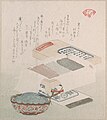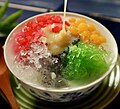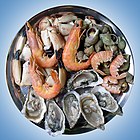식용해조류
Edible seaweed
식용 미역, 또는 해채류는 요리 목적으로 먹을 수 있고 사용할 수 있는 해조류입니다.[1] 일반적으로 많은 양의 섬유질을 함유하고 있습니다.[2][3] 그들은 홍조류, 녹조류, 갈조류와 같은 다세포 조류의 여러 그룹 중 하나에 속할지도 모릅니다.[2] 해조류는 또한 알지네이트, 한천 및 카라기난과 같은 다당류[4], 집합적으로 하이드로콜로이드 또는 피콜로이드로 알려진 젤라틴 물질의 추출을 위해 수확되거나 재배됩니다. 하이드로콜로이드는 특히 식품 첨가물로서 식품 생산에서 상업적인 중요성을 달성했습니다.[5] 식품 산업은 이러한 하이드로콜로이드의 겔화, 수분 유지, 유화 및 기타 물리적 특성을 활용합니다.[6]
대부분의 식용 해조류는 해양 조류인 반면 대부분의 담수 조류는 독성이 있습니다. 일부 해조류는 소화관을 자극하는 산을 함유하고 있고, 다른 해조류는 완하제 및 전해질 균형 효과를 가질 수 있습니다.[7] 대부분의 해양 거대 조류는 정상적인 양으로는 무독성이지만, 링비아 속의 구성체는 잠재적으로 치명적입니다.[8] 일반적으로, 중독은 링비아 또는 링비아를 먹인 다른 물고기를 먹음으로써 발생합니다;[8] 이것은 시가테라 중독이라고 불립니다.[8] 용종을 다루면 해조류 피부염을 일으킬 수도 있습니다.[9] 데스마레스티아의 일부 종은 심한 위장 장애를 일으킬 수 있는 황산 액포와 함께 고도로 산성입니다.[8]
분배
해조류는 특히 동아시아, 동남아시아 및 태평양 제도에서 전 세계 해안 요리의 음식으로 광범위하게 사용됩니다. 식용 해조류는 특히 중국, 일본, 한국, 필리핀 및 하와이 요리에서 두드러집니다.[10][11] 해조류는 전통적으로 인도네시아, 말레이시아, 싱가포르, 베트남, 미얀마, 스리랑카뿐만 아니라 미크로네시아, 멜라네시아, 폴리네시아 섬에서도 소비됩니다.[10] 뉴질랜드의 마오리족은 전통적으로 몇 종의 붉은 해초와 녹색 해초를 사용했습니다.[12] 몇몇 종들은 호주 원주민들도 먹습니다.[13]
해조류는 또한 많은 전통적인 유럽 사회들에서 소비되는데, 아이슬란드와 노르웨이 서부, 프랑스 대서양 연안, 아일랜드 북부와 서부, 웨일즈 및 남서부 잉글랜드의 일부 해안 지역과 [14]뉴브런즈윅, 노바스코샤, 뉴펀들랜드와 래브라도에서 소비됩니다. 김가루를 이용한 요리는 서반구에서 점점 더 인기를 얻고 있습니다.[15]
영양 및 용도

해조류는 단백질, 비타민, 미네랄, 식이섬유와 같은 영양소의 좋은 공급원입니다. 폴리페놀, 다당류, 스테롤뿐만 아니라 다른 생체 활성 분자도 해조류와 관련된 건강한 특성을 주로 담당합니다. 해조류를 육상 식물과 비교하면 에이코사펜타엔산(EPA)과 도코사헥사엔산(DHA) 지방산으로 필수 지방산의 비율이 더 높습니다.[16]
해조류는 다른 식품에 비해 높은 수준의 요오드, 티로신을 함유하고 있습니다.[17] 칼슘과 마그네슘도 풍부합니다.[18]
미역은 비타민 B12의 가능한 비건 공급원입니다.[19] 비타민은 공생 박테리아에서 얻어집니다.[20] 그러나 주류 영양은 해조류와 같은 조류 B12 공급원을 신뢰할 수 없다고 생각합니다.[21]
해조류는 다양한 요리에 사용됩니다.
- 김 (놀이) 싸먹는 초밥, 마키
- 국물에 김, 찌개, 전골
- 샐러드에 넣은 해초
- 김 스낵(예: 김 스낵) 통정원, 김대춘)
- 라면에 들어있는 김(예: 김) 종가, 사계, 농심)
사람이 아닌 사료:
- 가축의[22] 먹이가 되는 해조류
- 물고기 먹이로서의 해조류(aquarium & 양식장)
해조류에는 인간과 동물의 건강을 위한 프리바이오틱 기능성 성분으로 활용될 수 있는 다당류가 풍부합니다. 프리바이오틱스는 유익한 장내 미생물의 성장 및/또는 활동을 자극하여 숙주에 건강상의 이점을 제공하는 소화되지 않고 선택적으로 발효된 화합물입니다.[23] 또한 테르페노이드, 옥실리핀, 플로로탄닌, 휘발성 탄화수소, 혼합 생물유전학적 기원의 생성물 등 조류에 의해 합성되는 여러 2차 대사산물이 있습니다. 따라서 조류는 수많은 생물학적 활성을 갖는 화합물을 포함하고 있으며, 기능성 식품을 얻기 위한 많은 기술적 응용에서 기능성 성분으로 사용될 수 있기 때문에 큰 관심의 대상이 되는 천연 공급원으로 간주될 수 있습니다. 해조류의 다당류는 세균성 장 효소의 작용을 통해 사람의 체내에서 대사될 수 있습니다. 이러한 효소는 해조류를 섭취하기 때문에 일본 인구에서 자주 생산됩니다.[24]
콘드루스 크리스푸스(Chondrus crispus, 흔히 아일랜드 이끼로 알려져 있음)는 카파피쿠스 및 다양한 기가티노이드 해조류와 함께 다양한 식품 첨가물을 생산하는 데 사용되는 또 다른 홍조류입니다.
영양제로서 일부 식용 해조류는 항염증, 항알레르기, 항돌연변이, 항종양, 항당뇨, 항산화, 항고혈압 및 신경 보호 특성과 관련이 있습니다.[citation needed] 팔마리아 팔마타, 덜스, 포르피라 테네라, 아이제니아 바이시클리스와 같은 식용 붉은 거대 조류는 "대체 단백질, 미네랄, 그리고 결국 섬유질"의 관련 공급원으로 측정되었습니다.[25]
해조류인 아스파라곤시스 택포미스를 젖소에게 먹이면 메탄 배출을 줄일 수 있습니다.[26]
동아시아
아시아의 일부 지역에서는 海苔(일본에서는), 지카이 紫菜(중국에서는), 김(한국에서는), 김 김(한국에서는), 말린 홍조 포르피라(Porphyra) 한 장을 수프에 넣거나 초밥이나 오니기리를 싸는 데 사용합니다.
일본 요리는 7가지 종류의 해조류에 대한 일반적인 이름을 가지고 있기 때문에 일본어의 해조류 용어는 주로 과학적 응용 분야에서 사용되며 음식에 대한 언급은 아닙니다.
한천-한천(칸텐 寒天)은 젤라틴의 대체물로도 널리 사용됩니다. 그것의 일본에서의 사용은 17세기에 미노 타로자에몬이라는 여관 주인에 의해 우연히 발견되었다고 믿어집니다. 그러나 이 기원은 전설적입니다.[28]
'바삭바삭한 김'은 김이 아니라 양배추를 말린 후 튀긴 것으로 서양 중식당에서 자주 나오는 요리입니다.[29]
- 다시마(켈프)
- 19세기 쿠보 순만의 해초로 만든 케이크와 음식
동남아
바다 포도(Caulerpa lantillifera, Caulerpa racesmosa)와 구소(Eucheuma spp.)는 전통적으로 오세아니아뿐만 아니라 동남아시아의 요리에서 먹습니다.[30] 이 식용 온수 해조류는 필리핀에서 처음 상업적으로 재배되었습니다. 필리핀 북부에서는 냉수성 붉은 해조류인 포르피라 아트로푸레아, 파이로피아 비타넨시스, 할리메니아 포르모사 등이 전통적으로 야생에서 수확되어 요리의 재료로 사용되는 검은 노리 같은 시트로 건조되기도 합니다.[31][32][33][10]
수많은 다른 종의 해조류는 전통적으로 필리핀을 중심으로 동남아시아에서 먹지만 인도네시아(특히 인도네시아 동부), 말레이시아, 싱가포르, 베트남, 미얀마에서도 먹습니다. 여기에는 채토모르파, 엔테로모르파, 하이드로클라트루스, 파디나, 사르가섬, 팔리사다, 아가르디엘라, 그라실리아, 할리메니아, 로렌시아, 하이네아, 리아고라 및 사르코디아 속의 일부 구성체가 포함됩니다.[10]
필리핀에서 전통적인 재료는 주로 그라실리아 종에서 추출한 한천(1754년 스페인 사전에서 처음으로 입증됨)[34]과 카라기난([35]c.1637년에 처음으로 입증됨)으로 만든 굴라만(gulaman)입니다. 필리핀의 얕은 해양 해안 지역에서 자라는 유케우마 종(Eucheuma spp.). 현대에는 국내의 선구적인 열대 해조류 양식 산업에서도 대량 생산되고 있습니다. 젤라틴의 대체제로도 사용됩니다. 다양한 전통 디저트에 널리 사용되고 있습니다.[36][37][38] 젤라틴 대용품인 캐러지난은 인도네시아와 같은 동남아시아의 다른 지역으로도 퍼져나갔고 에스캄푸르와 같은 디저트에 사용됩니다.
해조류는 또한 알베이의 티위 주민들에 의해 국수로 가공되며, 이는 팬싯 칸톤, 팬싯 루그, 스파게티 또는 카르보나라로 요리될 수 있습니다.[39]
- 필리핀에서 온 말린 가메 디스크
일반 식용 해조류
일반적인 식용 해조류는[41][10][42] 다음과 같습니다.
참고 항목
참고문헌
- ^ Reynolds, Daman; Caminiti, Jeff; Edmundson, Scott J.; Gao, Song; Wick, Macdonald; Huesemann, Michael (2022-10-06). "Seaweed proteins are nutritionally valuable components in the human diet". The American Journal of Clinical Nutrition. 116 (4): 855–861. doi:10.1093/ajcn/nqac190. ISSN 0002-9165. PMID 35820048.
- ^ a b Garcia-Vaquero, M; Hayes, M (2016). "Red and green macroalgae for fish and animal feed and human functional food development". Food Reviews International. 32: 15–45. doi:10.1080/87559129.2015.1041184. hdl:10197/12493. S2CID 82049384.
- ^ K.H. Wong, Peter C.K. Cheung (2000). "Nutritional evaluation of some subtropical red and green seaweeds: Part I — proximate composition, amino acid profiles and some physico-chemical properties". Food Chemistry. 71 (4): 475–482. doi:10.1016/S0308-8146(00)00175-8.
- ^ Garcia-Vaquero, M; Rajauria, G; O'Doherty, J.V; Sweeney, T (2017-09-01). "Polysaccharides from macroalgae: Recent advances, innovative technologies and challenges in extraction and purification". Food Research International. 99 (Pt 3): 1011–1020. doi:10.1016/j.foodres.2016.11.016. hdl:10197/8191. ISSN 0963-9969. PMID 28865611. S2CID 10531419.
- ^ 1962년 F.E. 조류의 생물학. 에드워드 아놀드 주식회사
- ^ Garcia-Vaquero, M; Lopez-Alonso, M; Hayes, M (2017-09-01). "Assessment of the functional properties of protein extracted from the brown seaweed Himanthalia elongata (Linnaeus) S. F. Gray". Food Research International. 99 (Pt 3): 971–978. doi:10.1016/j.foodres.2016.06.023. hdl:10197/8228. ISSN 0963-9969. PMID 28865623.
- ^ Wiseman, John SAS 생존 핸드북
- ^ a b c d Turner, Nancy J.; von Aderkas, Patrick (2009). "3: Poisonous Plants of Wild Areas". The North American Guide to Common Poisonous Plants and Mushrooms. Portland, OR: Timber Press. pp. 115–6. ISBN 9780881929294. OCLC 747112294.
- ^ James, William D.; Berger, Timothy G.; et al. (2006). Andrews' Diseases of the Skin: clinical Dermatology. Saunders Elsevier. ISBN 978-0-7216-2921-6.
- ^ a b c d e Zaneveld, Jacques S. (1959). "The Utilization of Marine Algae in Tropical South and East Asia". Economic Botany. 13 (2): 89–131.
- ^ "Seaweed as Human Food". Michael Guiry's Seaweed Site. Retrieved 2011-11-11.
- ^ "Kai Recipe's used by Kawhia Maori & Early Pioneers". Kawhia.maori.nz. Retrieved 2011-11-11.
- ^ Thurstan, R. H.; Brittain, Z.; Jones, D. S.; Cameron, E.; Dearnaley, J.; Bellgrove, A. (2018-01-23). "Aboriginal uses of seaweeds in temperate Australia: an archival assessment". Journal of Applied Phycology. 30 (3): 1821–1832. Bibcode:2018JAPco..30.1821T. doi:10.1007/s10811-017-1384-z. hdl:10871/31766. ISSN 0921-8971. S2CID 22620932.
- ^ "Spotlight presenters in a lather over laver". BBC. 2005-05-25. Retrieved 2011-11-11.
- ^ "Famadillo - How to use seaweed flakes". Archived from the original on 12 April 2023.
- ^ Peñalver, Rocío; Lorenzo, José M.; Ros, Gaspar; Amarowicz, Ryszard; Pateiro, Mirian; Nieto, Gema (2020). "Seaweeds as a Functional Ingredient for a Healthy Diet". Marine Drugs. 18 (6): 301. doi:10.3390/md18060301. PMC 7345263. PMID 32517092.
- ^ "Micronutrient Information Center: Iodine". Oregon State University: Linus Pauling Institute. 2014-04-23. Retrieved 2011-11-11.
- ^ "Albay folk promote seaweed 'pansit'". ABS-CBN Regional Network Group. 2008-04-08. Retrieved 2009-08-04.
- ^ Watanabe, Fumio; Yabuta, Yukinori; Bito, Tomohiro; Teng, Fei (2014-05-05). "Vitamin B12-Containing Plant Food Sources for Vegetarians". Nutrients. 6 (5): 1861–1873. doi:10.3390/nu6051861. ISSN 2072-6643. PMC 4042564. PMID 24803097.
- ^ Smith AG (2019-09-21). "Plants need their vitamins too". Current Opinion in Plant Biology. 10 (3): 266–75. doi:10.1016/j.pbi.2007.04.009. PMID 17434786.
- ^ Melina V, Craig W, Levin S (2016). "Position of the Academy of Nutrition and Dietetics: Vegetarian Diets". J Acad Nutr Diet. 116 (12): 1970–80. doi:10.1016/j.jand.2016.09.025. PMID 27886704. S2CID 4984228.
Fermented foods (such as tempeh), nori, spirulina, chlorella algae, and unfortified nutritional yeast cannot be relied upon as adequate or practical sources of B-12.39,40 Vegans must regularly consume reliable sources—meaning B-12 fortified foods or B-12 containing supplements—or they could become deficient, as shown in case studies of vegan infants, children, and adults.
- ^ Makkar, Harinder P.S.; Tran, Gilles; Heuzé, Valérie; Giger-Reverdin, Sylvie; Lessire, Michel; Lebas, François; Ankers, Philippe (2016). "Seaweeds for livestock diets: A review". Animal Feed Science and Technology. 212: 1–17. doi:10.1016/j.anifeedsci.2015.09.018.
- ^ O'Sullivan, L.; Murphy, B.; McLoughlin, P.; Duggan, P.; Lawlor, P. G.; Hughes, H.; Gardiner, G. E. (2010). "Prebiotics from Marine Macroalgae for Human and Animal Health Applications". Marine Drugs. 8 (7): 2038–2064. doi:10.3390/md8072038. PMC 2920542. PMID 20714423.
- ^ Hehemann, Jan-Hendrik; Correc, Gaëlle; Barbeyron, Tristan; Helbert, William; Czjzek, Mirjam; Michel, Gurvan (8 April 2010). "Transfer of carbohydrate-active enzymes from marine bacteria to Japanese gut microbiota". Nature. 464 (7290): 908–912. Bibcode:2010Natur.464..908H. doi:10.1038/nature08937. PMID 20376150. S2CID 2820027.
- ^ Catarina, Costa; Filipa, Pimentel; Rita, Alves; Anabela, Costa; Arminda, Alves; Beatriz, Oliveira (2014). "Nutritional profile of edible red marine seaweeds". Frontiers in Marine Science. 1. doi:10.3389/conf.fmars.2014.02.00091. ISSN 2296-7745. OCLC 5707377199. Archived from the original on September 3, 2020.
- ^ Milman, Oliver (2021-03-18). "Feeding cows seaweed could cut their methane emissions by 82%, scientists say". The Guardian. Archived from the original on 2021-03-18. Retrieved 2021-11-24.
- ^ Nunez, Kirsten (31 December 2019). "4 Gelatin Substitutes Every Vegan or Vegetarian Needs to Try". Clean Green Simple. Retrieved 11 November 2021.
- ^ Mary Jo Zimbro; David A. Power; Sharon M. Miller; George E. Wilson; Julie A. Johnson (eds.). Difco & BBL Manual (PDF) (2nd ed.). Becton Dickinson and Company. p. 6. Archived from the original (PDF) on 2012-06-06. Retrieved 2013-07-17.
- ^ Hom, Ken (2012). "Crisp Seeweed". Good Food Channel. UK TV.CO.UK. Retrieved 16 October 2014.
- ^ Paul, Nicholas A.; Neveux, Nicolas; Magnusson, Marie; de Nys, Rocky (21 December 2013). "Comparative production and nutritional value of "sea grapes" — the tropical green seaweeds Caulerpa lentillifera and C. racemosa". Journal of Applied Phycology. doi:10.1007/s10811-013-0227-9. S2CID 15745994.
- ^ Adriano, Leilanie G. (21 December 2005). "'Gamet' sushi festival launched". The Manila Times. Retrieved 15 August 2021.
- ^ "Gamet". Museo Ilocos Norte. 28 May 2016. Retrieved 15 August 2021.
- ^ "Cagayan town passes seaweed protection law". The Manila Times. 15 December 2013. Retrieved 15 August 2021.
- ^ de Noceda, Juan; de Sanlucar, Pedro (1754). Vocabulario de la lengua Tagala. Imprenta de la compañia de Jesus. pp. 101, 215.
- ^ de Mentrida, Alonso (1841). Diccionario De La Lengua Bisaya, Hiligueina Y Haraya de la isla de Panay. En La Imprenta De D. Manuel Y De D. Felis Dayot. p. 380.
- ^ Marine Plants Section, National Fisheries Research and Development Institute. Gracilaria species in the Philippines (PDF). Bureau of Fisheries and Aquatic Resources, Department of Agriculture, Republic of the Philippines. Retrieved 12 March 2024.
- ^ Albert H. Wells (1916). "Possibilities of Gulaman Dagat as a Substitute for Gelatin in Food". The Philippine Journal of Science. 11: 267–271.
- ^ Montaño, Marco Nemesio E. (16 September 2004). "Gelatin, gulaman, 'JellyAce,' atbp". PhilStar Global. Retrieved 11 November 2021.
- ^ Blogger, Meridian Sea. "Cooking with Seaweed and the Health Benefits - Seaweed Varieties in UK". Meridian Sea Limited.
- ^ Dawes, Clinton J. (1998). Marine botany. New York: John Wiley. ISBN 978-0-471-19208-4.
- ^ Harrison, M. (2008). "Edible Seaweeds around the British Isles". Wild Food School. Archived from the original on 2015-07-21. Retrieved 2011-11-11.
- ^ Dumilag, Richard V.; Belgica, Teresa Haide R.; Mendoza, Lynn C.; Hibay, Janet M.; Arevalo, Abel E.; Malto, Mark Ariel D.; Orgela, Elden G.; Longavela, Mabille R.; Corral, Laurence Elmer H.; Olipany, Ruby D.; Ruiz, Caesar Franz C.; Mintu, Cynthia B.; Laza, Benilda O.; Pablo, Mae H. San; Bailon, Jinky D.; Berdin, Leny D.; Calaminos, Franklin P.; Gregory, Sheryll A.; Omoto, Annie T.; Chua, Vivien L.; Liao, Lawrence M. (15 September 2022). "Seaweed ethnobotany of eastern Sorsogon, Philippines". Algae. 37 (3): 227–237. doi:10.4490/algae.2022.37.8.16.
외부 링크
- 인간의 음식으로 사용되는 해조류 FAO 보고서







![Sea grapes (Caulerpa lentillifera) were originally cultivated in the Philippines. They are usually eaten raw with vinegar, as a snack or in a salad.[40]](http://upload.wikimedia.org/wikipedia/commons/thumb/a/a3/USAID_Measuring_Impact_Conservation_Enterprise_Retrospective_%28Philippines%3B_Nagkakaisang_Tribu_ng_Palawan%29_%2826420465388%29.jpg/120px-USAID_Measuring_Impact_Conservation_Enterprise_Retrospective_%28Philippines%3B_Nagkakaisang_Tribu_ng_Palawan%29_%2826420465388%29.jpg)






